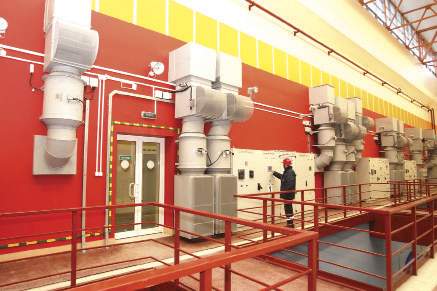President of Belarus, Alexander Lukashenko, has requested that the Grodno Region work towards greater investment activity with neighbouring Poland and Lithuania, speaking to the Chairman of the Grodno Regional Executive Committee during his report on prospects for social and economic development of the region

Grodno Hydroelectric Power Station has saved around $600,000 for the Republican budget
Mr. Lukashenko noted that the Grodno Region could perform better regarding foreign investments. Over the first nine months of 2014, just $49m was attracted net: almost half that of the same period of 2013.
The President asked what is made in the Grodno Region that might be of interest to neighbouring countries in the European Union — such as Lithuania and Poland. “Every year, you hold investment forums and there is a lot of noise in press, as there should be, but where is the result? You should have Polish and Lithuanian direct investments, instead of shuttle traders running to and from the border,” the President stressed.
The Head of State is convinced that almost a third of the population in border areas is generating income by trading with neighbouring European countries. He disapproves of this ‘generation of profiteers, who foster a shadow economy’ stating that they ‘won’t encourage profitable investments’.
He asked whether local authorities have been realising priority projects to develop manufacturing using local raw materials, import-substitution, and export-oriented production, and how entrepreneurial initiative is involved.
During his visit to the Grodno Hydroelectric Power Station, Mr. Lukashenko set the task of defining the number of new hydroelectric power stations being built in the immediate future in Belarus. Energy Minister Vladimir Potupchik explained that Belarus has 45 currently operational, with the 2011-2015 state programme having initially provided for the building or reconstruction of 33 hydroelectric power stations. Between 2011 and 2013, 16 were commissioned, with a general capacity of 18.7MW. In 2013, such power stations created 136.7 million kWh: 2.8 times more than in 2010.
The Ministry of Energy plans the realisation of three more projects within the programme. In particular, Polotsk hydroelectric power station is being built (21.75MW capacity) on the River Zapadnaya Dvina, as is Vitebsk hydroelectric power station (40MW capacity), and a site is planned at Nemanskaya (20MW capacity) on the River Nieman. In addition, there are also plans for Beshenkovichi hydroelectric power station, Verkhnedvinsk hydroelectric power station and a series of hydroelectric power plants on the River Dnieper. Hydroelectric power stations take time to ‘pay for themselves’ but are likely to prove profitable if gas prices rise.
Mr. Lukashenko is keen to support the installation of hydroelectric power stations but emphasises that the volume of building must be within feasible limits, since money for investment is not unlimited.
The First Deputy Prime Minister, Vladimir Semashko, believes that the building of hydroelectric power stations is reasonable, taking into account rises in gas prices long term. Energy Minister Vladimir Potupchik agrees that the long-term benefits are obvious. Mr. Lukashenko has charged them with fully examining the economic feasibility of further developing hydroelectric power stations in Belarus.











